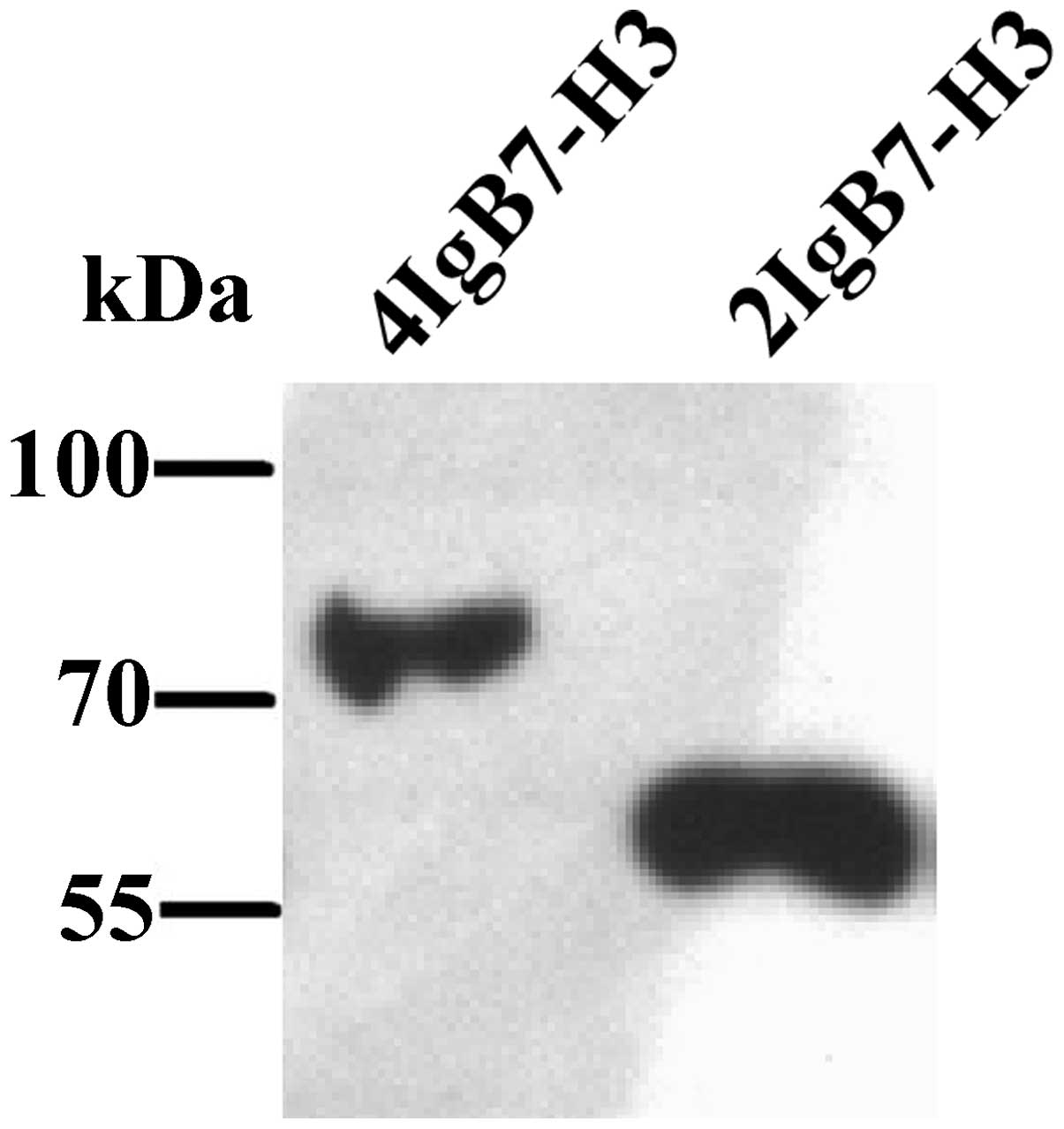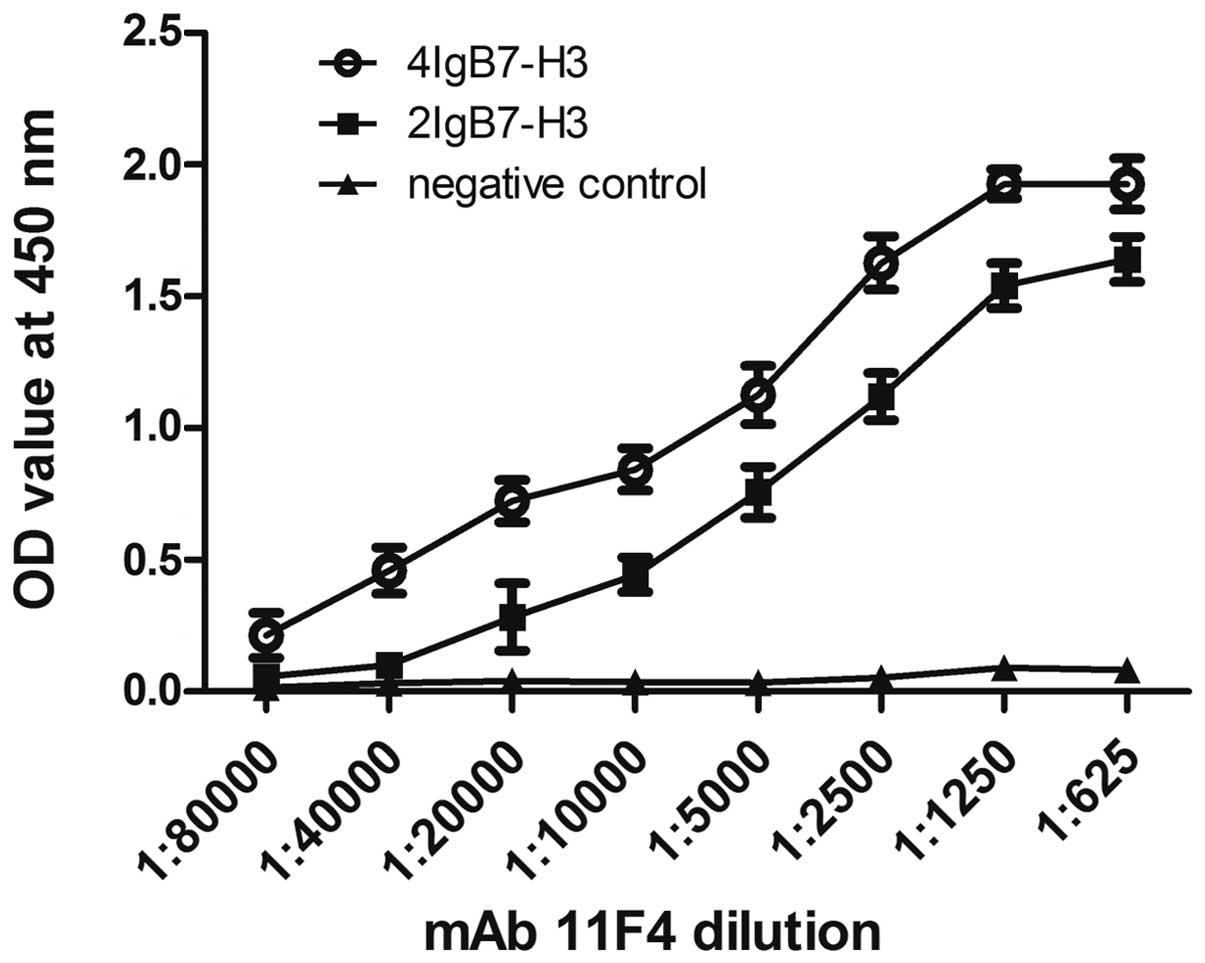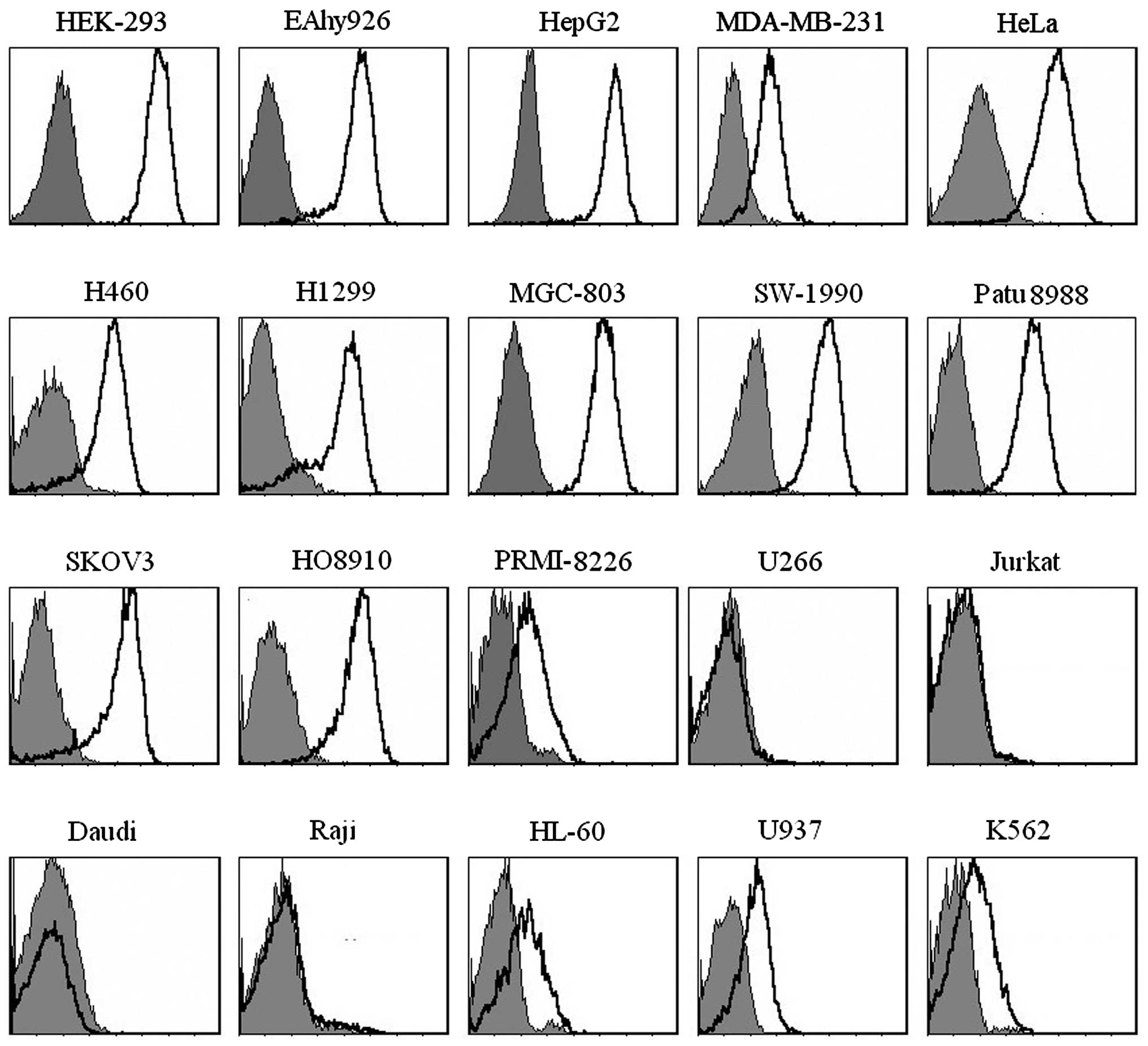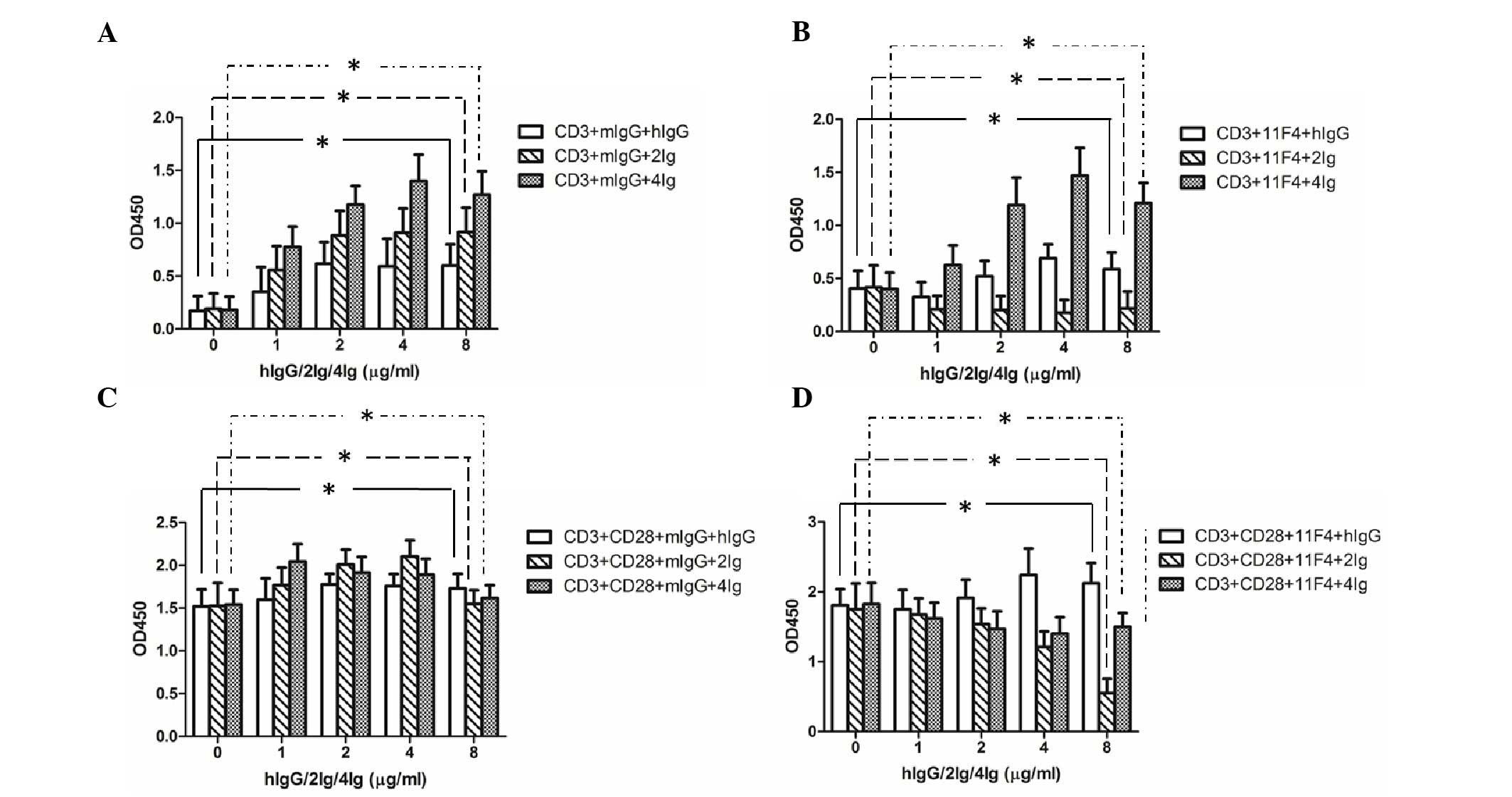Preparation and application of a novel monoclonal antibody specific for human B7-H3
- Authors:
- Published online on: May 17, 2016 https://doi.org/10.3892/mmr.2016.5288
- Pages: 943-948
Abstract
Introduction
Complete activation of T cells in response to donor alloantigen presentation requires the delivery of two separate, but complimentary signals. One is delivered via the antigen-specific T-cell receptor, following recognition of an alloantigen in the context of a major histocompatibility complex molecule expressed on an antigen-presenting cell. The other is introduced by the costimulatory molecules, which result from the ligation of the costimulatory receptor-ligand pair to deliver a positive or negative activation signal (1). The T-cell costimulatory molecules are predominantly comprised of the B7/CD28 superfamily and the tumor necrosis factor (TNF) family. In previous years, numerous members of the CD28 and B7 families have been identified, including programmed death-1 (PD-1), B and T lymphocyte attenuator, and the PD-L1, PD-L2, B7-H2, B7-H3 and B7-H4 ligands, which share similar protein domain structures consisting of one Ig-V-like domain and one Ig-C-like domain, which reside in the extracellular portion of the molecule (2-7).
B7-H3 is a novel member of the human B7 family, which shares 20–27% amino acids with other B7 family members (5). Differential splicing of human B7-H3 leads to a 4Ig domain (VCVC) transcript (4IgB7-H3) and a 2Ig domain (containing V1 and C2) transcript (2IgB7-H3) (8). The 4Ig transcript is the dominant form in human tissues. By contrast, the mouse B7-H3 gene encodes only a single VC domain form of B7-H3. Human and mouse B7-H3 mRNAs are expressed broadly in lymphoid and non-lymphoid organs (5,9). Soluble B7-H3-Ig binds to activated T cells, costimulating their proliferation and the production of interferon (IFN)-γ (5). However, several studies have indicated that B7-H3 has an inhibitory function. 2IgB7-H3 and 4IgB7-H3 have similar functions and can downregulate T cell responses (10,11). Thus, further investigations are required to elucidate the contradictory results regarding the functions of B7-H3.
In order to analyze the expression pattern of B7-H3 at the protein level, and compare the biological function of the two B7-H3 isoforms, the present study generated one B7-H3 monoclonal antibody (mAb; clone 11F4), which was able to recognize 2IgB7-H3 and 4IgB7-H3. The 11F4 mAb was used to detect the expression of B7-H3 in tumor cell lines. The B7-H3 protein was expressed broadly on the surface of the tumor cells, with the exception of certain hematopoietic cell lines. Subsequently, the 2IgB7-H3 and 4IgB7-H3-Fc fusion protein was obtained using NIH3T3/2IgB7-H3, and the NIH3T3/4IgB-H3 stable expressing system was constructed. Notably, 2IgB7-H3 and 4IgB7-H3 exhibited a similar costimulatory function in promoting T cell proliferation. The 11F4 mAb inhibited the positive effect activated by the B7-H3 fusion proteins.
Materials and methods
Preparation and culture of cells
The SP2/0 mouse myeloma cell line, NIH/3T3 mouse embryo fibroblast cell line, HEK293 human embryonic kidney cell line, EAhy926 endothelial cell line, the human tumor cell lines (HO8910, H460, SKOV3, SW-1990, Patu8988, HepG2, MDA-MB-231, HeLa and MGC-803), the human malignant hematopoietic cell lines (Raji, Daudi, Jurkat, U266, U937, K562 and HL-60) and RPMI-8226) were obtained from American Type Culture Collection (Manassas, CA, USA). All the cell lines were cultured in RPMI-1640 medium (Gibco; Thermo Fisher Scientific, Inc., Waltham, MA, USA) or standard Dulbecco's modified Eagle's medium (DMEM; Gibco; Thermo Fisher Scientific, Inc.) supplemented with 10% fetal calf serum (FCS; GE Healthcare Life Sciences, Logan, UT, USA), 100 U/ml penicillin and 100 μg/ml streptomycin (Sigma-Aldrich, St. Louis, MO, USA) and 2 mM L-glutamine (Sigma-Aldrich). The cells were cultured in a 5% CO2, 37°C incubator.
Animals and reagents
The present study was approved by the ethics committee of the Affiliated Hospital of Nantong University (Nantong, China). Female BALB/c mice (age, six weeks) were purchased from the Department of Experimental Animal (Shanghai Institute of Biological Products, Ministry of Health of China, Shanghai China). The three mice were housed together in an environment of 25°C with a natural light/dark cycle and food and water provided every day. A series of anti-human mAbs, including mouse monoclonal CD3 (clone UCHT1; 1:3,000; cat. no. ab119110) and mouse monoclonal IgG1 (1:3,000; cat. no. ab91353) were purchased from Abcam (Cambridge, MA, USA). Horseradish peroxidase (HRP)-conjugated goat anti-mouse IgG was purchased from Santa Cruz Biotechnology, Inc. (Dallas, Texas, USA; cat. no. sc-2031; 1:3,000). Functional CD28 monoclonal mouse antibody (1:1,000; cat. no. MAB342), and anti-His Tag mouse monoclonal antibody (1:1,000; cat. no. MAB050) were purchased from R&D Systems, Inc. (Minneapolis, MN, USA).
Preparation of T cells and DCs
Peripheral blood mononuclear cells (PBMCs) were separated from 50 ml healthy human peripheral blood (Nantong Central Blood Bank, Nantong, China) using Ficoll-Hypaque (TBD science, Tianjin, China) gradient centrifugation at 800 x g for 20 min at room temperature. Monocytes were prepared from the PBMCs by removing non-adherent cells to deplete the T cells, B cells and natural killer cells following 2 h incubation in 6-well culture plates at 37°C. The T lymphocytes were isolated by classic erythrocyte-rosetting due to binding between sheep red blood cells and T lymphocytes (12,13). The purity of the T lymphocytes was >90%. The adherent monocytes were cultured in RPMI-1640 medium containing 10% FCS with human recombinant GM-CSF (500 U/ml; R&D Systems, Inc.) and human recombinant IL-4 (200 U/ml; R&D Systems, Inc.) to obtain monocyte-derived dendritic cells (mdDCs). Maturation of the mdDCs was achieved by incubating the cells with TNF-α (100 U/ml; R&D Systems, Inc.) for 48 h at 37°C.
Production of B7-H3 cDNA
Total RNA was prepared from the mdDCs using TRIzol reagent (Invitrogen; Thermo Fisher Scientific, Inc.) and was used for complementary DNA (cDNA) synthesis with a Superscript First-Strand Synthesis kit (Takara Bio, Inc., Dalian, China), according to the manufacturer's instructions. The genes encoding the extracellular domain of the two B7-H3 isoforms (accession number: NM_001024736 and accession number: NM_025240.2) were amplified from the pMD19-T/4IgB7-H3 and pMD19-T/2IgB7-H3 vectors using polymerase chain reaction (PCR) amplification with the following primers: B73b-A 5′-GCTAAGCTTCTGCGTCGGCGGGGCAGCCCT-3′ (Hind III site shown in italics) and B73b-B 5′-CCTGGATCCTCAGGCTATTTCTTGTCCA-3′ (BamH I site shown in italics) using Premix Taq™ (Takara Bio, Inc.). The thermocycling conditions were as follows: 3 min at 95°C for polymerase activation; followed by 35 cycles of denaturation at 95°C for 40 sec, annealing at 57°C for 45 sec, and extension at 72°C for 1 min.
Expression of the 4IgB7-H3 and 2IgB7-H3 recombinant proteins
The 4IgB7-H3 and 2IgB7-H3 cDNA were subcloned into the pSectag2B mammalian expression vector (Invitrogen; Thermo Fisher Scientific, Inc.), which carries the C-terminal His-tag for purification and detection. The two types of cDNA were respectively introduced into NIH3T3 cells, which contain endogenous furin to cleave propeptide and release the mature metalloprotease (14), using Lipofectamine™ 2000 (Invitrogen; Thermo Fisher Scientific, Inc.). The transfected cells were maintained in DMEM supplemented with 10% FCS, 100 U/ml penicillin, 100 μg/ml streptomycin and 2 mM L-glutamine at 37°C, with 95% air and 5% CO2. Cells expressing the recombinant protein were selected in medium containing 400 μg/ml hygromycin-B (Invitrogen; Thermo Fisher Scientific, Inc.), in which cells expressing high levels of 4IgB7-H3 and 2IgB7-H3 were selected by single-cell cloning. The recombinant 4IgB7-H3 and 2IgB7-H3 was collected from the supernatant of the confluent cells grown in serum-free medium, and purified through the C-terminal His-tag using Protino Ni-NTA Agarose (Macherey-Nagel, Düren, Germany).
Generation and characterization of mouse anti-human B7-H3 mAbs
The six-week-old BALB/c mice were separately immunized with four injections of purified recombinant 4IgB7-H3 at 21-day intervals. The first three injections were 0.1 mg subcutaneous injections and the fourth was a 0.05 mg caudal vein injection. Subsequently, 4 days after the final injection, the immunized mice were sacrificed by cervical dislocation. The spleen cells were separated using a mesh screen. The splenocytes and murine myeloma SP2/0 cells were fused at a ratio of 10:1 by PEG4000 (Invitrogen; Thermo Fisher Scientific, Inc.) within 2 min. The cells were subsequently cultured at 37°C in 5% CO2. The procedure was conducted according to the method described by Groth and Scheidegger (15). Following 2 weeks of hypoxanthine-aminopterin-thymidine selection (Sigma-Aldrich), one hybridoma cell line secreting mouse anti-human B7-H3 mAb (11F4) was obtained, exhibiting high reactivity with recombinant 4IgB7-H3 using an enzyme linked immunosorbent assay (ELISA). The mAbs were purified on Protein G-Sepharose CL4B (Pharmacia, Uppsala, Sweden) affinity columns, and the Ig isotypes were identified using rapid test paper (Roche Diagnostics, Varilhes, France).
Binding assay
A 96-well plate (Corning Incorporated, Corning, NY, USA) was coated with recombinant 4IgB7-H3 or 2IgB7-H3 protein (10 μg/ml; 100 μl/well) in 0.05 M carbonate/bicarbonate buffer (pH 9.6) overnight at 4°C. Recombinant human lipopolysaccharide-binding protein (LBP) with a C-terminal 6-His tag (R&D Systems, Inc.) was used as a negative control protein. The wells were washed three times with 0.1% Tween 20-phosphate-buffered saline (PBS; PBST; Sigma-Aldrich) and blocked with 2% (w/v) bovine serum albumin (BSA; Sigma-Aldrich) in PBS for 2 h at 37°C. Following incubation, the plate was incubated with PBS containing the 11F4 B7-H3 mAb (1 μg/μl, between 1:80,000 and 1:625) for 1 h at 37°C. Following washing six times with PBST, the plate was incubated with HRP-conjugated goat anti-mouse IgG in 0.1% PBST-BSA buffer at 37°C for another 1 h, followed by incubation with tetramethylbenzidine detection reagent (Thermo Fisher Scientific, Inc.). The reactions were terminated with 3 M sulfuric acid (Sigma-Aldrich) and the absorbance of each sample was read at 450 nm on a microplate reader (Varioskan™ Flash; Thermo Fisher Scientific, Inc.). All the groups were performed in triplicate, respectively.
Flow cytometric analysis
For flow cytometric analysis, the target cells (1×106) were incubated with mouse anti-human B7-H3 11F4 mAbs for 30 min at 37°C and washed with PBS. Fluorescein isothiocyanate (FITC)-labeled goat anti-mouse IgG (BD Biosciences, San Jose, CA, USA), as a secondary antibody, was added for another 30 min at 37°C at a concentration of 1 mg/L. Following washing with PBS, the cells were analyzed using a flow cytometer (Cytomics FC 500, Beckman Coulter, Brea, CA, USA) and with Expo32 MultiCOMP software (Beckman Coulter).
Western blot analysis
Western blot analysis was performed to analyze the binding capacity of the 11F4 mAb to the 4IgB7-H3 and 2IgB7-H3 protein on NIH3T3/4IgB7-H3 or NIH3T3/2IgB7-H3 cells, respectively. NIH3T3/mock cells were used as a negative control. The cell lysate was separated using 12% sodium dodecyl sulfate-polyacrylamide gel electrophoresis, transferred onto nitrocellulose filters and stained with 11F4 mAb. The protein bands were visualized using ECL Western Blotting Substrate (Bio-Rad Laboratories, Inc., Hercules, CA, USA).
T cell proliferation
For the T cell proliferation assay, a 96-well flat-bottom plate was precoated with anti-CD3 mAb (0.3 μg/ml) at 4°C overnight. The purified T cells were then seeded into the wells (1×105/well) to co-culture with recombinant human IgG (hIgG), 2IgB7-H3 and 4IgB7-H3 (0–8 μg/ml), respectively. The 11F4 mAb (10 μg/ml) was added to the culture system, with or without anti-CD28 mAb (1 μg/ml). Cell Counting Kit-8 (CCK-8) solution (16) was added to each well, and the cells were incubated at 37°C for another 5 h. The absorbance was measured at 450 nm using a microplate reader (Thermo Fisher Scientific, Inc.). All experiments were performed in triplicate.
Results
Purified human 4IgB7-H3 and 2IgB7-H3 fusion protein
The transfected NIH3T3 cell lines secreting recombinant the 4IgB7-H3 and 2IgB7-H3 protein were successfully constructed. The supernatant was collected and purified by the C-terminal His-tag using Protino Ni-NTA Agarose. The recombinant protein was well identified by the mouse monoclonal anti-His antibody (Santa Cruz Biotechnology, Inc.; cat. no. sc-8036; Fig. 1).
Establishment of 11F4, a novel mouse anti-human B7-H3 mAb
The Balb/c mice were immunized with purified recombinant 4IgB7-H3 protein and the splenocytes were fused with murine myeloma SP2/0 cells. Following repeated screening using recombinant 4IgB7-H3 protein and multiple subcloning using ELISA, one hybridoma, termed 11F4, was obtained. The isotope of 11F4 was mouse IgG1 with a κ light chain, and the hybridoma contained >100 chromosomes, indicating it was fusant (data not shown). Notably, 11F4 was observed to bind specifically to both the recombinant 4IgB7-H3 and 2IgB7-H3 protein (Fig. 2). In addition, the NIH3T3/4IgB7-H3 and NIH3T3/2IgB7-H3 transfectants were stained by 11F4 using flow cytometry (Fig. 3A) and western blotting (Fig. 3B).
B7-H3 protein is broadly expressed on the human tumor cell lines
The expression patterns of B7-H3 on human tumor cell lines were detected by 11F4 using flow cytometry. The results demonstrated that B7-H3 was broadly and highly expressed on tumor cell lines, whereas no B7-H3 was detected was detected at had low levels on human malignant hematopoietic cell lines (Fig. 4).
2IgB7-H3 and 4IgB7-H3 signaling enhance T-lymphocyte proliferation and 11F4 inhibits this enhancement effect
The purified T cells were stimulated with the anti-CD3 mAb and co-cultured with recombinant hIgG, 2IgB7-H3 and 4IgB7-H3, respectively. The results revealed that 2IgB7-H3 and 4IgB7-H3 were able to promote T-cell proliferation, and the 11F4 antibody exhibited an inhibitory effect, to a certain extent. In addition, the inhibitory effect on the 2IgB7-H3 group was more marked, compared with the effect on the 4IgB7-H3 group (Fig. 5A and B). In the presence of anti-human CD28 mAb, the effect on proliferation was enhanced. Notably, the inhibitory effect of 11F4 was markedly increased following co-incubation with anti-CD3 mAb, anti-CD28 mAb and recombinant B7-H3 (Fig. 5C and D).
Discussion
B7-H3 is a type I transmembrane protein belonging to the B7 superfamily (5,9). B7 superfamily proteins provide stimulatory or inhibitory accessory signals for T cell responses. Due to exon duplication, the extracellular architecture of B7-H3 is characterized by a single IgV-IgC-like (2IgB7-H3) or IgV-IgC-IgV-IgC-like (4IgB7-H3) domain (8,9). The different roles of 2IgB7-H3 and 4IgB7-H3 in the immune system remain to be fully elucidated. In the present study, NIH3T3/4IgB7-H3 and NIH3T3/2IgB7-H3 transfectants were successfully constructed, and the two isoforms of recombinant protein were obtained (Fig. 1). In addition, a novel mAb, termed, 11F4 against human 2IgB7-H3 and 4IgB7-H3 was established (Figs. 2 and 3).
B7-H3 are ubiquitously expressed in a wide spectrum of tissues, however, its protein expression is relatively limited and maintained at low levels. The mRNA transcription of B7-H3 is inconsistent with its protein expression, suggesting the existence of a complex post-transcriptional regulatory mechanism. In addition, the expression of B7-H3 has been described in malignancies, including glioma, and lung, pancreatic, ovarian, breast, gastric and colon cancer (17-22). However, a correlation between the expression of B7-H3 on cancer cells and pathological results remains to be fully elucidated. In the present study, using the 11F4 mAb, high expression levels of B7-H3 were broadly expressed on tumor cell lines at the protein level. Normal cell lines, including HEK-293 and EAhy926 cell lines also exhibited high expression levels of B7-H3. Notably, B7-H3 was not be detected on several human malignant hematopoietic cell lines, including U266, Jutkat, Daudi and Raji cells, while PRMI-8226, HL-60, U937 and K562 cells were observed to exhibit low or moderate expression levels of B7-H3 (Fig. 4), similar to previously reported observations (23,24). It has been reported that the majority of these tumor cell lines express 4IgB7-H3, rather than 2IgB7-H3 (24).
As with other members of the B7 family, B7-H3 is important in costimulatory pathways in T cells. However, the function of B7-H3 remains controversial. Chapoval et al reported that B7-H3 costimulates the proliferation of CD4+ and CD8+ T cells, enhances the induction of cytotoxic T cells and selectively stimulates IFN-γ production in the presence of T cell receptor signaling (5). Other reports have indicated that B7-H3, with its two isoforms of 2IgB7-H3 and 4IgB7-H3, may have a similar inhibitory function (10,11). In the T cell proliferation assay performed in the present study, the biological functions of these two isoforms were found to be similar, positive regulating the T cells. The 11F4 mAb effectively inhibited the B7-H3 signal, resulting in inhibition of T cell proliferation.
In conclusion, the present study successfully generated a novel specific mouse anti-human B7-H3 mAb (11F4), with the ability to recognize 4IgB7-H3 and 2IgB7-H3. Using this mAb, high expression levels of B7-H3 were observed in tumor cells, as in previous reports. The recombinant 4IgB7-H3 and 2Ig-B7-H3 proteins enhanced T cell proliferation, and the effect of B7-H3 on the promotion of T cell proliferation was further verified using 11F4 in an inhibitory assay. The role of 4IgB7-H3 and 2Ig-B7-H3 on accessory signals in T cell functions, and whether the two isoforms have different receptors, requires further investigation.
References
|
Chen W, Hou Z, Li C, Xiong S and Liu H: Cloning and characterization of porcine 4Ig-B7-H3: a potent inhibitor of porcine T-cell activation. PLoS One. 6:e213412011. View Article : Google Scholar : PubMed/NCBI | |
|
Latchman Y, Wood CR, Chernova T, Chaudhary D, Borde M, Chernova I, Iwai Y, Long AJ, Brown JA, Nunes R, et al: PD-L2 is a second ligand for PD-1 and inhibits T cell activation. Nat Immunol. 2:261–268. 2001. View Article : Google Scholar : PubMed/NCBI | |
|
Selenko-Gebauer N, Majdic O, Szekeres A, Höfler G, Guthann E, Korthäuer U, Zlabinger G, Steinberger P, Pickl WF, Stockinger H, et al: B7-H1 (programmed death-1 ligand) on dendritic cells is involved in the induction and maintenance of T cell anergy. J Immunol. 170:3637–3644. 2003. View Article : Google Scholar : PubMed/NCBI | |
|
Dong C, Juedes AE, Temann UA, Shresta S, Allison JP, Ruddle NH and Flavell RA: ICOS co-stimulatory receptor is essential for T-cell activation and function. Nature. 409:97–101. 2001. View Article : Google Scholar : PubMed/NCBI | |
|
Chapoval AI, Ni J, Lau JS, Wilcox RA, Flies DB, Liu D, Dong H, Sica GL, Zhu G, Tamada K and Chen L: B7-H3: A costimulatory molecule for T cell activation and IFN-gamma production. Nat Immunol. 2:269–274. 2001. View Article : Google Scholar : PubMed/NCBI | |
|
Sica GL, Choi IH, Zhu G, Tamada K, Wang SD, Tamura H, Chapoval AI, Flies DB, Bajorath J and Chen L: B7-H4, a molecule of the B7 family, negatively regulates T cell immunity. Immunity. 18:849–861. 2003. View Article : Google Scholar : PubMed/NCBI | |
|
Tafuri A, Shahinian A, Bladt F, Yoshinaga SK, Jordana M, Wakeham A, Boucher LM, Bouchard D, Chan VS, Duncan G, et al: ICOS is essential for effective T-helper-cell responses. Nature. 409:105–109. 2001. View Article : Google Scholar : PubMed/NCBI | |
|
Steinberger P, Majdic O, Derdak SV, Pfistershammer K, Kirchberger S, Klauser C, Zlabinger G, Pickl WF, Stöckl J and Knapp W: Molecular characterization of human 4Ig-B7-H3, a member of the B7 family with four Ig-like domains. J Immunol. 172:2352–2359. 2004. View Article : Google Scholar : PubMed/NCBI | |
|
Sun M, Richards S, Prasad DV, Mai XM, Rudensky A and Dong C: Characterization of mouse and human B7-H3 genes. J Immunol. 168:6294–6297. 2002. View Article : Google Scholar : PubMed/NCBI | |
|
Ling V, Wu PW, Spaulding V, Kieleczawa J, Luxenberg D, Carreno BM and Collins M: Duplication of primate and rodent B7-H3 immunoglobulin V- and C-like domains: Divergent history of functional redundancy and exon loss. Genomics. 82:365–377. 2003. View Article : Google Scholar : PubMed/NCBI | |
|
Suh WK, Gajewska BU, Okada H, Gronski MA, Bertram EM, Dawicki W, Duncan GS, Bukczynski J, Plyte S, Elia A, et al: The B7 family member B7-H3 preferentially down-regulates T helper type 1-mediated immune responses. Nat Immunol. 4:899–906. 2003. View Article : Google Scholar : PubMed/NCBI | |
|
Indiveri F, Huddlestone J, Pellegrino MA and Ferrone S: Isolation of human T lymphocytes: Comparison between nylon wool filtration and rosetting with neuraminidase (VCN) and 2-aminoethylisothiouronium bromide (AET)-treated sheep red blood cells (SRBC). J Immunol Methods. 34:107–115. 1980. View Article : Google Scholar : PubMed/NCBI | |
|
Madsen M, Johnsen HE, Hansen PW and Christiansen SE: Isolation of human T and B lymphocytes by E-rosette gradient centrifugation. Characterization of the isolated subpopulations. J Immunol Methods. 33:323–336. 1980. View Article : Google Scholar : PubMed/NCBI | |
|
Shapiro J, Sciaky N, Lee J, Bosshart H, Angeletti RH and Bonifacino JS: Localization of endogenous furin in cultured cell lines. J Histochem Cytochem. 45:3–12. 1997. View Article : Google Scholar : PubMed/NCBI | |
|
de StGroth SF and Scheidegger D: Production of monoclonal antibodies: Strategy and tactics. J Immunol Methods. 35:1–21. 1980. View Article : Google Scholar : PubMed/NCBI | |
|
Ishiyama M, Miyazono Y, Sasamoto K, Ohkura Y and Ueno K: A highly water-soluble disulfonated tetrazolium salt as a chromogenic indicator for NADH as well as cell viability. Talanta. 44:1299–1305. 1997. View Article : Google Scholar : PubMed/NCBI | |
|
Zhou Z, Luther N, Ibrahim GM, Hawkins C, Vibhakar R, Handler MH and Souweidane MM: B7-H3, a potential therapeutic target, is expressed in diffuse intrinsic pontine glioma. J Neurooncol. 111:257–264. 2013. View Article : Google Scholar | |
|
Boland JM, Kwon ED, Harrington SM, Wampfler JA, Tang H, Yang P and Aubry MC: Tumor B7-H1 and B7-H3 expression in squamous cell carcinoma of the lung. Clin Lung Cancer. 14:157–163. 2013. View Article : Google Scholar | |
|
Fauci JM, Sabbatino F, Wang Y, Londoño-Joshi AI, Straughn JM Jr, Landen CN, Ferrone S and Buchsbaum DJ: Monoclonal antibody-based immunotherapy of ovarian cancer: Targeting ovarian cancer cells with the B7-H3-specific mAb 376.96. Gynecol Oncol. 132:203–210. 2014. View Article : Google Scholar | |
|
Arigami T, Narita N, Mizuno R, Nguyen L, Ye X, Chung A, Giuliano AE and Hoon DS: B7-h3 ligand expression by primary breast cancer and associated with regional nodal metastasis. Ann Surg. 252:1044–1051. 2010. View Article : Google Scholar : PubMed/NCBI | |
|
Wu CP, Jiang JT, Tan M, Zhu YB, Ji M, Xu KF, Zhao JM, Zhang GB and Zhang XG: Relationship between co-stimulatory molecule B7-H3 expression and gastric carcinoma histology and prognosis. World J Gastroenterol. 12:457–459. 2006. View Article : Google Scholar : PubMed/NCBI | |
|
Sun J, Chen LJ, Zhang GB, Jiang JT, Zhu M, Tan Y, Wang HT, Lu BF and Zhang XG: Clinical significance and regulation of the costimulatory molecule B7-H3 in human colorectal carcinoma. Cancer Immunol Immunother. 59:1163–1171. 2010. View Article : Google Scholar : PubMed/NCBI | |
|
Castriconi R, Dondero A, Augugliaro R, Cantoni C, Carnemolla B, Sementa AR, Negri F, Conte R, Corrias MV, Moretta L, et al: Identification of 4Ig-B7-H3 as a neuroblastoma-associated molecule that exerts a protective role from an NK cell-mediated lysis. Proc Natl Acad Sci U S A. 101:12640–12645. 2004. View Article : Google Scholar : PubMed/NCBI | |
|
Zhou YH, Chen YJ, Ma ZY, Xu L, Wang Q, Zhang GB, Xie F, Ge Y, Wang XF and Zhang XG: 4IgB7-H3 is the major isoform expressed on immunocytes as well as malignant cells. Tissue Antigens. 70:96–104. 2007. View Article : Google Scholar : PubMed/NCBI |














